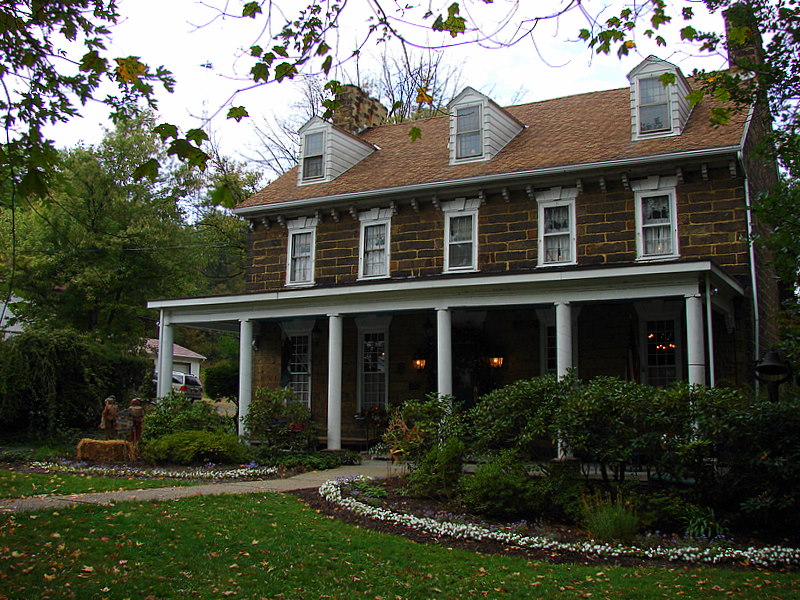
SCENERY HILL, Pa. (AP) – George Washington slept there, as did fellow Presidents Andrew Jackson and James Polk. But for Megin Harrington, the Century Inn was home – and one she looked after for 40 years as if it were a family member.
“You do it lovingly,” Harrington, 67, said Tuesday as she stood outside the 200-year-old property in Scenery Hill, a hamlet in North Bethlehem, Washington County, and assessed the destruction left by her worst fear.
An overnight fire ripped through the stone structure built in the late 1700s that housed The McCune Saloon, one of the country’s longest-operating taverns. No one was hurt.
“The loss of the building is bad enough, but the loss of what they had in there is probably just as bad or worse,” said Ed Schultz, 45, of Scenery Hill. “This town was built around that building. It’s like losing the center of town.”
The fire around midnight drew at least nine fire companies and took hours to bring under control, state police said. A malfunction in the mechanical room appeared to be the cause, a state police fire marshal determined.
Harrington said she was working on payroll for her 10 employees in her third-floor living quarters when the fire started. Her oldest son, Chip, was having a glass of wine in the first-floor bar when he smelled smoke and called for her to get out.
There were no guests since the six-bedroom inn, along with its restaurant and tavern, was closed on Mondays and Tuesdays.
“Grab the flag – grab the Whiskey Rebellion flag,” Harrington said she called out to her son.
The flag, depicting an eagle and 13 stars, is the only known survivor from the 1790s uprising in Western Pennsylvania over a federal excise tax on distilled spirits. Representatives from the Smithsonian have sought to have the flag donated to their collection, Harrington said.
Harrington instinctively thought to save the flag because of its rarity and historical value.
“That, and I couldn’t get a 10-foot highboy out of there fast enough on my back,” she said. That prized antique cabinet is believed to date to 1750.
Authorities are working to calculate damages.
Harrington said she needs to see what her insurance company says before deciding whether to rebuild – or even if she can.
In addition to antique furniture, Harrington collected historical documents, century-old hair wreaths people once weaved in family members’ honor, 18th- and 19th-century cross-stitched alphabet samplers, and old baskets that coal miners used to carry canaries underground.
Aside from the flag, the condition of most items in the building is unknown. That includes a Victrola phonograph that belonged to Harrington’s great-grandmother and a portrait of Harrington that hung inside the tavern.
Opened by Thomas Hill in 1794 along the National Road and called “Hill’s Stone Tavern,” the property hosted presidents and other notable guests such as Revolutionary War military officer Marquis de Lafayette and Mexican President Antonio Lopez de Santa Anna. Albert Gallatin, the first U.S. Treasury secretary, stayed there, as did Whiskey Rebellion leader David Bradford and Indian Chief Black Hawk.
Dr. Gordon Harrington and his wife, Mary, bought the property in 1945. Megin Harrington married their son, Gordon Harrington Jr. She continued to run the inn and its 27 acres after he died in a 1987 plane crash.
“Words cannot describe how devastating this loss is to our community,” said Randi Marodi, president of the Bentleyville Area Historical Society, which includes Scenery Hill. “To the people of Scenery Hill, this was their anchor.”
The front door of the 20-room inn opened to a foyer and music room, which was one of five dining rooms for the restaurant. The entrance to the saloon stood to the right, with a stately staircase just beyond that led to second-floor guest rooms.
Kady Durko, 24, of Cokeburg worked at the inn during high school and college.
Never a history buff, Durko said stories about the inn fascinated her – as did a stone step leading into the main dining room.
“It was worn down in the middle from people constantly walking through,” she said. “It really just showed the true character. All the historic memories that are there and the people who stayed in certain rooms, that’s all gone now.”
The U.S. National Park Service added the inn to the National Register of Historic Places in 1974.
The blue outside door stood ajar Tuesday, allowing a glimpse inside the darkened foyer. Water showered down from the second floor, splashing on the bottom steps of the staircase.
Smoke billowed from the burned out upstairs, the roof gone and parts of the second floor collapsed. The stone facade stood strong except for the chimney crown, which had crumbled inward.
Neighbor Shirley Gaudette worked with others to collect what could be salvaged. Their finds littered the front porch: piles of framed art and documents, soot-covered silver sets, soaked guest books.
“There aren’t too many of these old buildings around anymore,” said Gaudette, 63, as she clutched wet, burned family photos. “It’s a beautiful inn that has been here for so long. The base is here, and it has a solid foundation. Hopefully, it will grow from that base.”
___
By JASON CATO, Pittsburgh Tribune-Review
Online:
http://bit.ly/1NEMRnc
___
Information from: Pittsburgh Tribune-Review, http://pghtrib.com
Copyright 2015 Associated Press. All rights reserved. This material may not be published, broadcast, rewritten, or redistributed.
AP-WF-08-19-15 1512GMT


